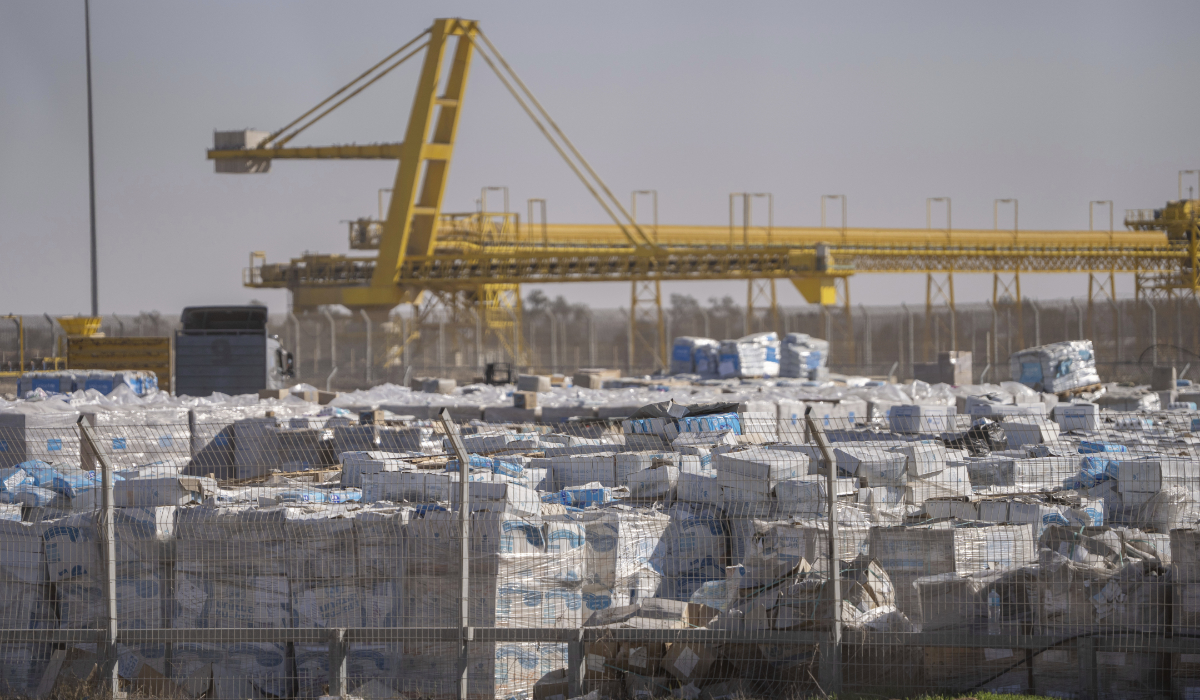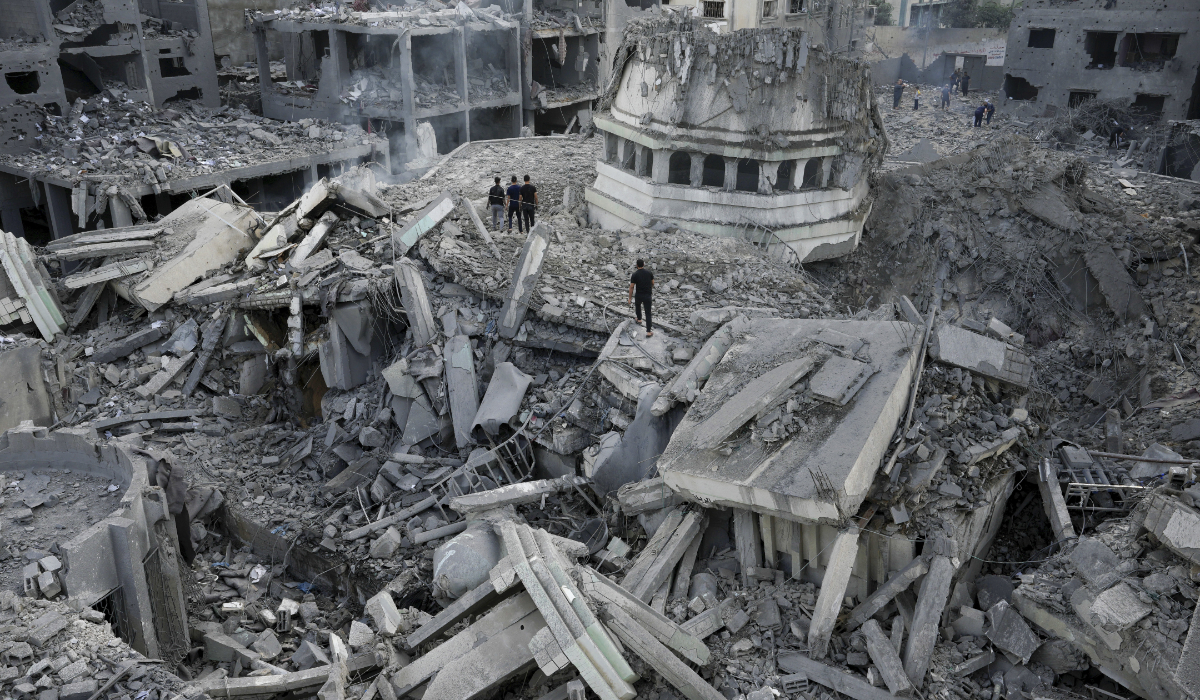CAIRO: If the Israel-Hamas ceasefire deal goes according to the current draft, then fighting will stop in Gaza for 42 days, and dozens of Israeli hostages and hundreds of Palestinian prisoners will be freed. In this first phase Israeli troops will pull back to the edges of Gaza, and many Palestinians will be able to return to what remains of their homes as stepped-up aid flows in.
The question is if the ceasefire will survive beyond that first phase.
That will depend on even more negotiations meant to begin within weeks. In those talks, Israel, Hamas, and the U.S, Egyptian and Qatari mediators will have to tackle the tough issue of how Gaza will be governed, with Israel demanding the elimination of Hamas.
Without a deal within those 42 days to begin the second phase, Israel could resume its campaign in Gaza to destroy Hamas – even as dozens of hostages remain in the militants’ hands.

Humanitarian aid sits, waiting to be picked up on the Palestinian side of the Kerem Shalom aid crossing in the Gaza Strip, on Dec. 19, 2024. (AP)
Hamas has agreed to a draft of the ceasefire deal, two officials confirmed, but Israeli officials say details are still being worked out, meaning some terms could change, or the whole deal could even fall through. Here is a look at the plan and potential pitfalls in the draft seen by the Associated Press.
Swapping hostages for imprisoned Palestinians
During the first phase, Hamas is to release 33 hostages in exchange for the freeing of hundreds of Palestinians imprisoned by Israel. By the end of the phase, all living women, children and older people held by the militants should be freed.
Some 100 hostages remain captive inside Gaza, a mix of civilians and soldiers, and the military believes at least a third them are dead.
On the first official day of the ceasefire, Hamas is to free three hostages, then another four on the seventh day. After that, it will make weekly releases.
Which hostages and how many Palestinians will be released is complicated. The 33 will include women, children and those over 50 — almost all civilians, but the deal also commits Hamas to free all living female soldiers. Hamas will release living hostages first, but if the living don’t complete the 33 number, bodies will be handed over. Not all hostages are held by Hamas, so getting other militant groups to hand them over could be an issue.

Palestinians inspect the rubble of the Yassin Mosque after it was hit by an Israeli airstrike at Shati refugee camp in Gaza City, on Oct. 9, 2023. (AP)
In exchange, Israel will free 30 Palestinian women, children or elderly for each living civilian hostage freed. For each female soldier freed, Israel will release 50 Palestinian prisoners, including 30 serving life sentences. In exchange for bodies handed over by Hamas, Israel will free all women and children it has detained from Gaza since the war began on Oct. 7, 2023.
Dozens of men, including soldiers, will remain captive in Gaza, pending the second phase.
Israeli pullbacks and the return of Palestinians
During the proposed deal’s first phase, Israeli troops are to pull back into a buffer zone about a kilometer (0.6 miles) wide inside Gaza along its borders with Israel.
That will allow displaced Palestinians to return to their homes, including in Gaza City and northern Gaza. With most of Gaza’s population driven into massive, squalid tent camps, Palestinians are desperate to get back to their homes, even though many were destroyed or heavily damaged by Israel’s campaign.
But there are complications. During the past year of negotiations, Israel has insisted it must control the movement of Palestinians to the north to ensure Hamas does not take weapons back into those areas.
Throughout the war, the Israeli military has severed the north from the rest of Gaza by holding the so-called Netzarim Corridor, a belt across the strip where troops cleared out the Palestinian population and set up bases. That allowed them to search people fleeing from the north into central Gaza and bar anyone trying to return.
The draft seen by the AP specifies that Israel is to leave the corridor. In the first week, troops would withdraw from the main north-south coastal road — Rasheed Street — which would open one route for Palestinians returning. By the 22nd day of the ceasefire, Israeli troops are to leave the entire corridor.
Still, as talks continued Tuesday, an Israeli official insisted the military will keep control of Netzarim and that Palestinians returning north would have to pass inspections there, though he declined to provide details. The official spoke on condition of anonymity to discuss closed negotiations.
Working out those contradictions could bring frictions.
Throughout the first phase, Israel will retain control of the Philadelphi Corridor, the strip of territory along Gaza’s border with Egypt, including the Rafah Crossing. Hamas dropped demands that Israel pull out of this area.
Humanitarian aid
In the first phase, aid entry to Gaza is to be ramped up to hundreds of trucks a day of food, medicine, supplies and fuel to alleviate the humanitarian crisis. That is far more than Israel has allowed in throughout the war.
For months, aid groups have struggled to distribute to Palestinians even the trickle of aid entering Gaza because of Israeli military restrictions and rampant robberies of aid trucks by gangs. An end to fighting should alleviate that.
The need is great. Malnutrition and diseases are rampant among Palestinians, crammed into tents and short on food and clean water. Hospitals have been damaged and short of supplies. The draft deal specifies that equipment will be allowed in to build shelters for tens of thousands whose homes were destroyed and to rebuild infrastructure like electricity, sewage, communications and road systems.
But here, too, implementation could bring problems.
Even before the war, Israel has restricted entry of some equipment, arguing it could be used for military purposes by Hamas. Another Israeli official said arrangements are still being worked out over aid distribution and cleanup, but the plan is to prevent Hamas from having any role.
Further complicating matters, Israel’s government is still committed to its plan to ban UNRWA from operating and to cut all ties between the agency and the Israeli government. The UN agency is the major distributor of aid in Gaza and provides education, health and other basic services to millions of Palestinian refugees across the region, including in the Israeli-occupied West Bank.
The second phase
If all of that works out, the sides must still tackle the second phase. Negotiations over it are to begin on Day 16 of the ceasefire.
Phase two’s broad outlines are laid out in the draft: All remaining hostages are to be released in return for a complete Israeli withdrawal from Gaza and a “sustainable calm.”
But that seemingly basic exchange opens up much bigger issues.
Israel has said it will not agree to a complete withdrawal until Hamas’ military and political capabilities are eliminated and it cannot rearm — ensuring Hamas no longer runs Gaza. Hamas says it will not hand over the last hostages until Israel removes all troops from everywhere in Gaza.
So the negotiations will have to get both sides to agree to an alternative for governing Gaza. Effectively, Hamas has to agree to its own removal from power — something it has said it is willing to do, but it may seek to keep a hand in any future government, which Israel has vehemently rejected.
The draft agreement says a deal on the second phase must be worked out by the end of the first.
Pressure will be on both sides to reach a deal, but what happens if they don’t? It could go in many directions.
Hamas had wanted written guarantees that a ceasefire would continue as long as needed to agree on phase two. It has settled for verbal guarantees from the United States, Egypt and Qatar.
Israel, however, has given no assurances. So Israel could threaten new military action to pressure Hamas in the negotiations or could outright resume its military campaign, as Prime Minister Benjamin Netanyahu has threatened.
Hamas and the mediators are betting the momentum from the first phase will make it difficult for him to do that. Relaunching the assault would risk losing the remaining hostages — infuriating many against Netanyahu — though stopping short of destroying Hamas will also anger key political partners.
The third phase is likely to be less contentious: The bodies of remaining hostages would be returned in exchange for a 3- to 5-year reconstruction plan to be carried out in Gaza under international supervision.



























